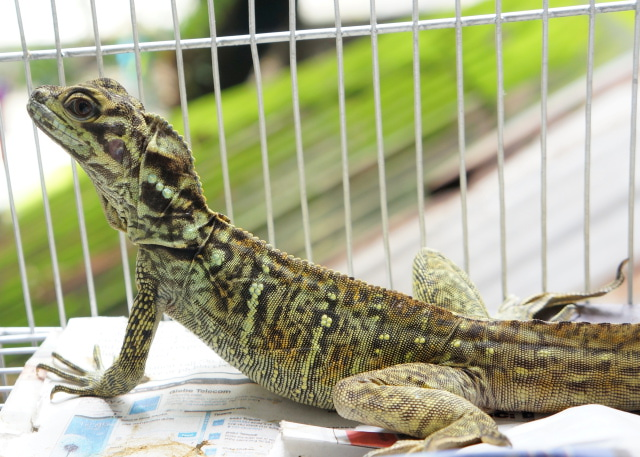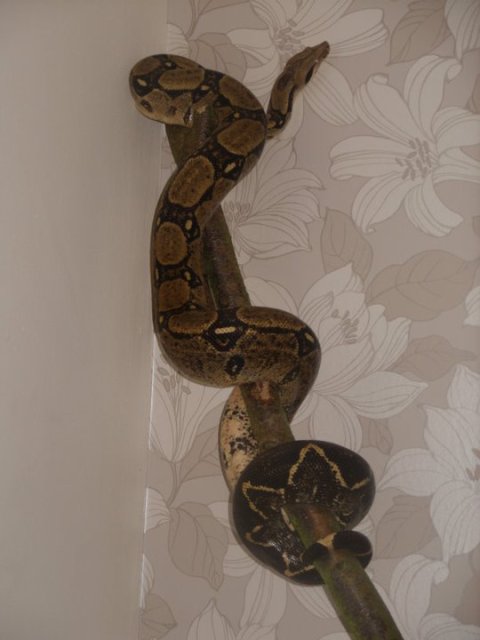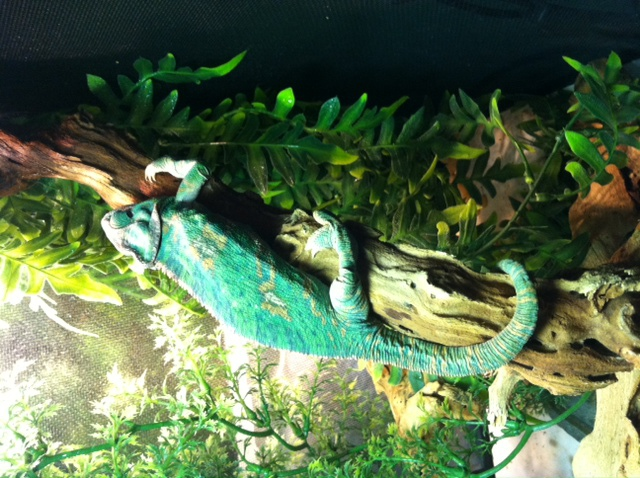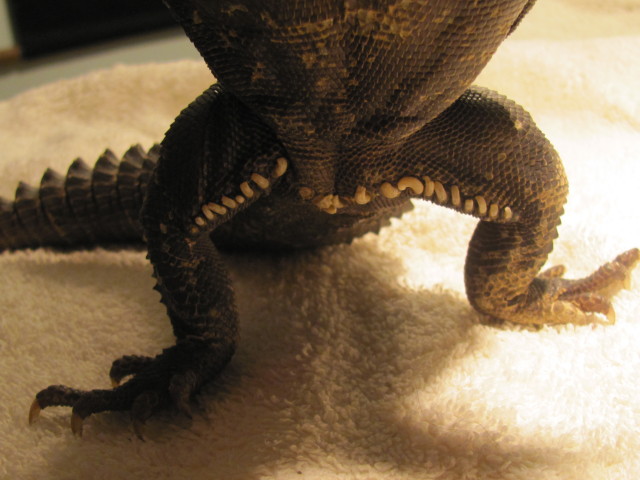QuestionMy gecko is a little over a year old. We got him in nov. 2007 and he ate well for about a month and then refused to eat for about a week or better. During that time we were learning about them by reading what we could and I had read that they could eat fruit so we rubbed applesauce with a little calcium on a Q tip on his mouth and in a few days he was eating again and has had a really good appetite until about two weeks ago and he is doing the same thing again and this being the same time of the year makes me wonder if this is normal for this time of year. He has eaten a couple of crickets lately.I know he ate one on 12/26 and he ate another one 01/04. I want to know about misting how and why you would do that? He seems to be moving around more in his home and looks out of the glass and sometimes acts like he is trying to climb the glass walls.I don't see him drink much although he lays his head on the edge of his water dish
and he seems to enjoy that because he naps there. Hope you can help me!
Answer Leos need mistings to rehydrate and condition their skins. I wouls also check his temps to make sure your own change in climate is not affecting his. He should be eating more. I'm giving you a proper caresheet to compare to your set-up to make any other changes needed.
CARE FOR A LEOPARD GECKO
Leopards are pretty easy to care for but they do need
special care. Here are some of the basic needs of your
gecko.
HOUSING: The need to have at least a 20 gallon long tank for
one Leo. This needs to have a secure fitting screen top...they can be quite the escape artists!!! They need to have a humid hide box.You can make
this with something as simple as a small plastic dish with a
hole cut in one side and a small mesh bag filled with some
Sphagnum moss, coconut bark or Peat moss that you mist.
I made mine out of the small plastic Folgers coffee containers...I cut an opening in the lid..and put the moss in..they LOVE it. I use the terrarium moss in mine.
I use that on the warm side of the tank. Be sure to provide a cool hidebox on the other end. I also provide a mid temperature hide...which is in the middle of the tank.I use the critter caves which you can purchase. NOT the ones that have heat in them!!!!
Provide secure climbing areas for your gecko. Fake plants, rocks and branches are all fine to use. be sure there are no wires or sharp ends to any fake plants you use.
SUBSTRATE:(that's the stuff on the floor of your tank) News
paper, lizard carpet or paper towels work great and are easy
to clean and are much safer than any loose substrate. Sand or other loose substrate is not recommended as that they can be deadly to the leo when it is ingested(eaten, even by accident while eating their insects)...
TEMPERATURES: They need a warm area of 88-92 degrees and a
cooler area in the upper 70s, low 80s. At night their
temperature can drop to the low to mid 70's.
Never use a hot rock for a leopard gecko...or any reptile.
They can severely burn any reptile. You can use a heating
pad under the tank,under tank heater, or you can use a regular household
lightbulb in a dome fixture with a ceramic socket in it to
keep the warm area at the 88-90 degree area.At night, no white light. If room temperatures stay above 70 degrees, no extra night heat is needed. The undertank heater or heating pad should cover about 1/3 of the tank....be sure to raise the tank up about 1/4-1/2 inch off the stand when using an undertank heat source to prevent heat build up which can cause the glass to break and hot spots in the glass. Be sure to have a good layer of newspaper, carpeting or, even a thin flat rock(such as tile) on top the area that the undertank heat source is placed...if you use a thin rock or tile, it helps to distribute the heat very well.
You can use the special nighttime lights that are designed for reptiles. I like using a ceramic heat emitter on a thermostat for nighttime heat.
DO NOT use black lights or party lights as they can cause eye damage!!!!
The wattage you use will vary based on room temperature and size of tank.
LIGHTING: Leopard geckos do not need UVB lighting but it does not hurt them to give them uvb. They should have some type of light during the day, be it a uvb tube, regular florescent light, reptile day light or regular household lightbulb. NO white lights at night!!!
FEEDING: Geckos should not be fed crickets or other insects that are bigger than the space between their eyes. Crickets and other food items such as silk worms, super, and an occasional treat of a wax worm, need to be dusted with a calcium supplement two times a week and also they should have a small dish of calcium in their tank. I use the lid of a milk jug for the little dish of calcium in their tank. For dusting the insects, Use a calcium with no added phosphorus. I use Rep Cal brand. The plain calcium for in the dish and I use the calcium with D3 to dust the insects.
Insects must be gut loaded(fed) for at least 48 hours prior to feeding your gecko. Remove any uneaten crix or superworms after 15-20 minutes..... Place a piece of cut potato in the tank so that if you have missed any uneaten insects, they will eat the potato instead of nibbling on your gecko!!!
You have to be sure to feed your crickets the right foods
before feeding them to your gecko. If your crickets/insects are not healthy and well fed, your gecko will not get the nutrition
he needs. You can gut load your crickets greens, veggies, cereals or specially designed commercial foods for crickets or the insects you are feeding.
Be sure to have a small dish of clean water for your gecko
at all times!!
You can offer them some baby food or fruits on occasion ...
Mine will even eat a small piece of watermelon now and then.
WATER: always provide a dish of drinking water. If you choose to mist your gecko to drink, its best to not get the tank too wet as that they do not do well with higher humidity. Sometimes its better to take your leo out of their tank to mist them to get them to drink!!! Above normal room humidity levels of 30-40% can cause breathing problems in the leos.
HANDLING: Some geckos enjoy being held...others prefer not to be handled at all. Be sure to be very gentle when holding your leo and NEVER grab them by the tail! Their tails are extremely fragile and will break.
I do suggest finding a vet that can treat reptiles BEFORE you actually need one!!! To find a vet that is able to care for reptiles:
http://www.anapsid.org/vets
For more information on leopard geckos:
http://www.thegeckospot.com/leocareindex2.html
http://www.drgecko.com

 Identifying Sailfin lizard species
QuestionQUESTION: Hello Tracie, Ive been keeping a juve
Identifying Sailfin lizard species
QuestionQUESTION: Hello Tracie, Ive been keeping a juve
 boa behaviour change
Question
Tink Our Snake
Hi, we have what we think is a
boa behaviour change
Question
Tink Our Snake
Hi, we have what we think is a
 Bearded Dragon - Eye issue
QuestionStella 1
QUESTION: Hey,
I have a bearded
Bearded Dragon - Eye issue
QuestionStella 1
QUESTION: Hey,
I have a bearded
 1 year old female veiled chameleon
QuestionLizzy
Lizzys Setup
QUESTION: I ha
1 year old female veiled chameleon
QuestionLizzy
Lizzys Setup
QUESTION: I ha
 Uro parasite??? Please help, urgent
Question
Underside of uro loop
Hi Cathy,
Ive h
Uro parasite??? Please help, urgent
Question
Underside of uro loop
Hi Cathy,
Ive h